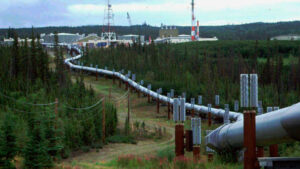BREAKING — October 4, 2025
On this day in history — October 4, — a drunken gunman fired on the Trans‑Alaska Pipeline, triggering one of the worst environmental disasters in Alaska’s modern era.

Daniel Carson Lewis, under the influence, shot a .338‑caliber rifle into the pipeline near Livengood. The bullet pierced the thick steel wall—designed to withstand such attacks—and ruptured the line. The result: a crude oil geyser, blasting 285,000 gallons (≈6,800 barrels / ~1 million litres) into pristine forest and tundra. Officials described the scene in stark terms. One prosecutor called it “a case of an idiot with a gun … out along the pipeline with alcohol.” Trees and ground cover were drenched in crude; crews raced to contain the spread.
With the pipeline pressurized at over 500 psi, the oil sprayed violently—so forcefully that as one FBI agent put it, “If you would have put your hand in front of the leak, the pressure would have taken it off.”
The spill forced a near‑shutdown of crude production: North Slope output dropped to just 5 % while the line was repaired.
After about 64 hours offline, the pipeline was brought back to full capacity.
Lewis was swiftly arrested and later convicted on multiple counts including criminal mischief, assault, weapons misconduct, and oil pollution. He received concurrent federal and state sentences, and was ordered to pay millions in cleanup costs—though authorities noted it was unlikely he could cover the entire bill.
The spill became historically significant: the second largest mainline pipeline rupture in Alaska’s history. Today, the legacy of that single errant shot remains a cautionary tale in infrastructure security and environmental risk. Would you like me to pull up a new feature or retrospective on pipeline safety since then?
